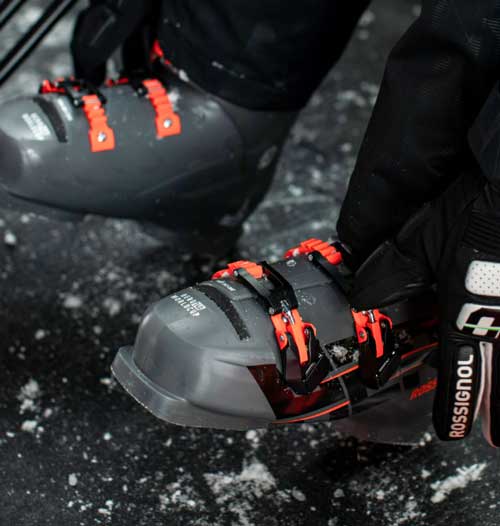
DEEP DIVE
WARNING: this is an extremely in depth explainer about bootfitting, the foot and skiing dynamics.
We go through the parts of the ski boot, biomechanics of skiing, foot structure, how to support the foot and FAQs.
The Ski Boot
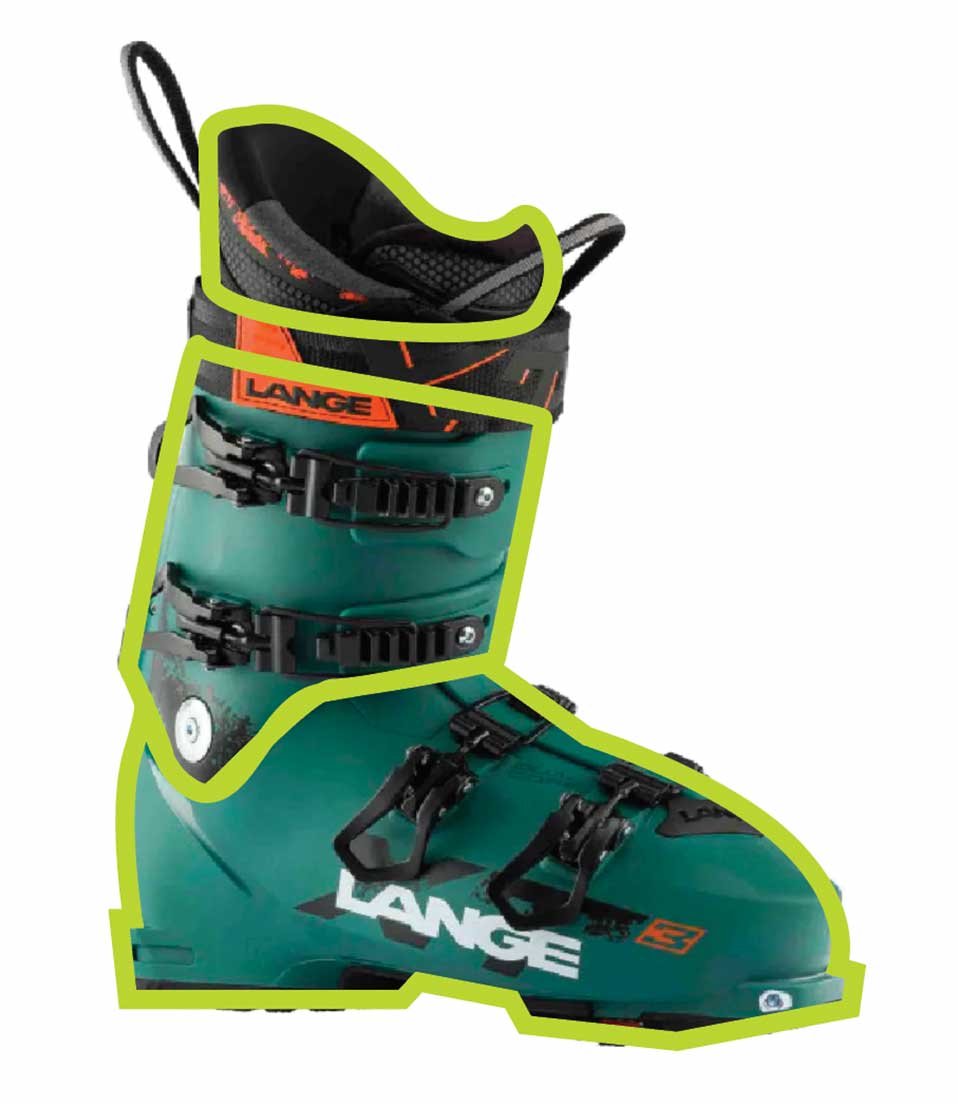
The Ski Boot
Shell
The Shell envelopes the foot and provides support against the various forces while inversely acting as a transmitter of the users inputs through first the binding and onto the ski.
Cuff
The upper cuff attaches to the shell and works like a lever to transmit forces from the skier’s leg to the shell enveloping the foot.
The way in which the cuff and shell are connected mimics the anatomical function of the ankle joint. This both supports ankle mobility while inversely bracing the skier to remain vertical on an inclined ski slope.
Liner
The liner is the soft textile link between the inner form created from the hard plastic cuff and shell and the users foot. It provides the all important comfort, insulation and final support for the foot in the ski boot.
Choosing a Boot
Volume and Performance
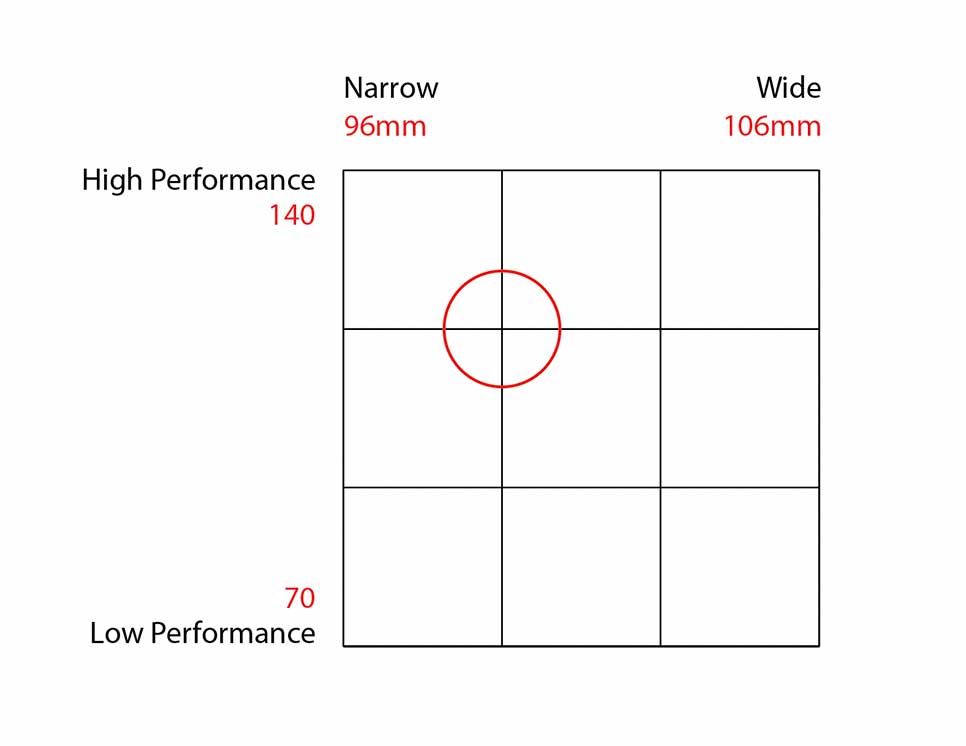
Choosing a Boot
Volume and Performance
Choosing a boot requires our fitters to access your goals, your fitness, your weight, the length and width of your foot. We then use a matrix to narrow down the choices. If you are a high performance skier; at flex index of 120-140 would be recommended. If you are just starting; 70-90. There are other factors that make up the best choice.
We also measure your instep, width and length of the foot. This measurment helps us choose the best volume ski boot: a narrow, low volume ski boot would be 96-98mm wide. A high volume foot would require a 102-106mm last.
Foot Structure

Foot Structure
The foot mainatins balance by distributing the downward forces to the heel (calcaneus), the outer (fifth met) and inner (first met). This three point weight distribution is like a stool or tripod.
We now have to support the 4th leg: the arch for optimal performace. This requires a footbed/insole. A custom or trim-to-fit insole is always recommended for the best outcome.
Instep: how tall is your foot? We measure over your arch. We take this into important consideration as if it's not accommodated blood flow (dorsal venous arch) will be limited and . The instep also gives you heel retention. To measure this we take a soft tape and measure from your outside heel to your inside heel.
Bunion, surgery, protrusions: these are modifications and are covered under our Bootfit Guarantee.
Leg volume: match the volume of the leg matches the boot. This is important as a mismatch could either cause a reduction in blood flow or shin bang.
Supporting the Foot
Insole
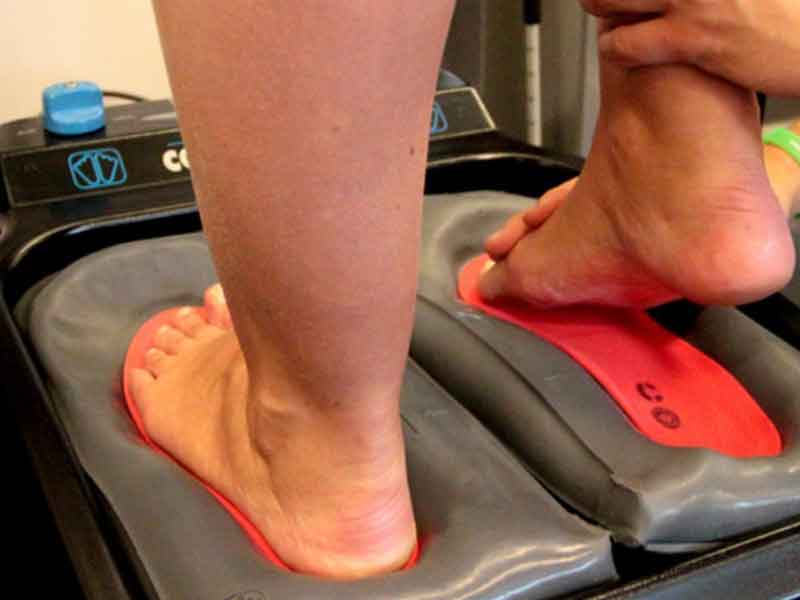
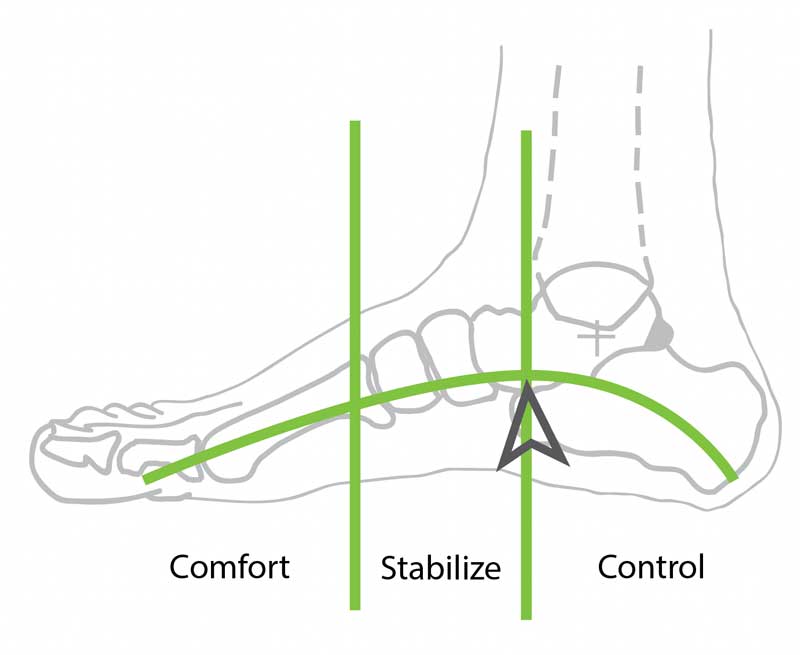
Supporting the Foot
Insole
The most important step in the bootfitting process is supporting the foot. All the comfort, stability, control and steering happens with a properly supported foot.

We have two options: a trim-to-fit ($60) option where we select the correct arch height then trim the insole to length. The more advanced option is a fully custom insole ($190) where the technician will take a mold of your foot and heat the insole material to create the perfect level of comfort, stability and control.
Helps with: alignment, bloodflow.
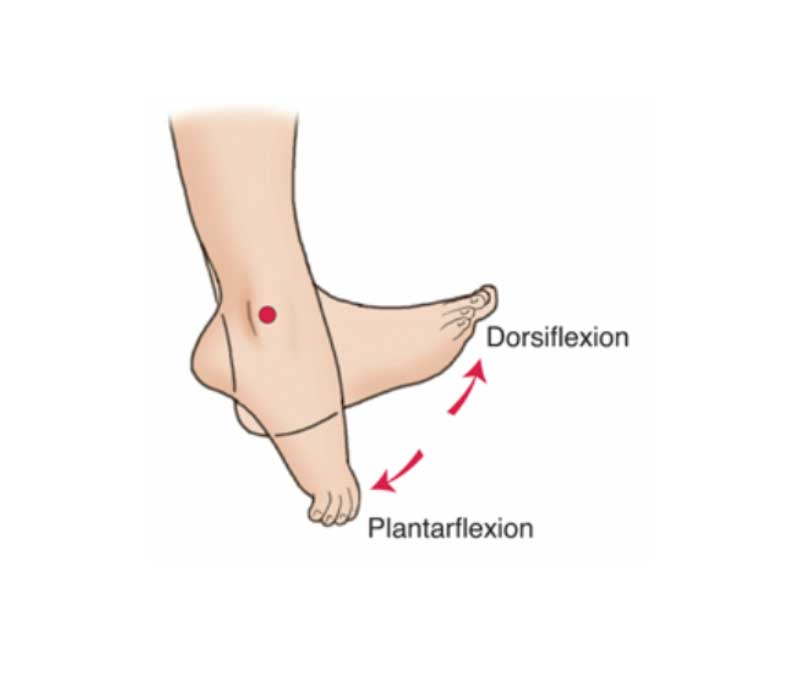
Dorsiflexion
If there is lack of range of motion in the ankle then there could be more pressure in the met arch, a feeling of not being able to lift the forefoot.
How we measure: hand under the foot or paper trick.
Solve? with heel lift and sometimes a stiffer boot.
Hyper mobile foot: need a stiffer boot.
Questions: how many days a year do you go? What other sports to you do? Injuries? FFFS. Fun, Frequency, Footwear, Sports. Have you owned your own ski boots before?
How do I know if the flex is correct for me? In the store if you can move your knee to the tip of the boot it's the correct flex.
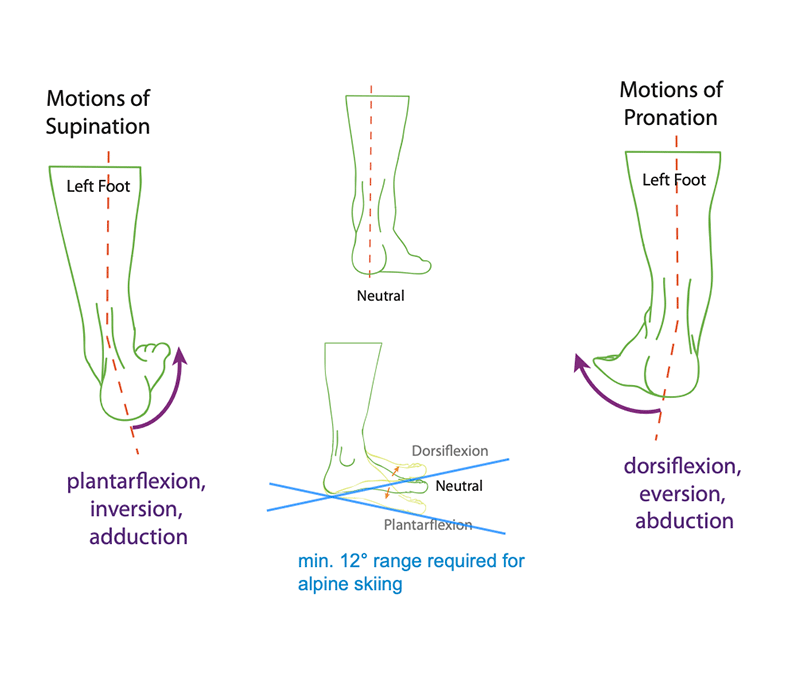
Range of Motion
Gait Cycle At heel strike the rear foot is inverted which allows the heel to
contact the ground at its lateral border. If you look at most shoes,
the heel will be worn on the outside. Through the sub-talar joint,
this allows for rapid pronation as a way to both absorb energy
and unlock the foot to aid in balance.
The ranges of motion and relationship between the joints of the lower extremities serve three purposes: 1) Propulsion 2) Energy absorption 3) Balance.
Recognizing the features of a skier's natural build will help to assess their potential for skiing and optimize their performance through adjustments to equipment and alignment. Just as some people are natural runners, there are those who are built to ski. Most people will require some alterations in equipment and alignment to optimize their balance and technique.
Kinetic Chain
The phrase ‘kinetic chain’ is used to describe the link- ages and related movements of the joints of the lower extremities, and indeed, the whole body. To focus on the movement of one joint, while ignoring the ones above and below it, is inadequate for both understanding ski technique and for diagnosing and solving problems related to the alignment and movement of the legs.
In skiing, from the bottom up: Pronation of the feet allows internal rotation of the lower leg which is necessary for knee angluation. From the top down: Internal rotation of the upper leg (steering effort) loads the arch of the foot. It also helps to create knee angulation by rotating the knee medially - when the knee flexes, its mass will move inside the arc.
The big picture
Biomechanics
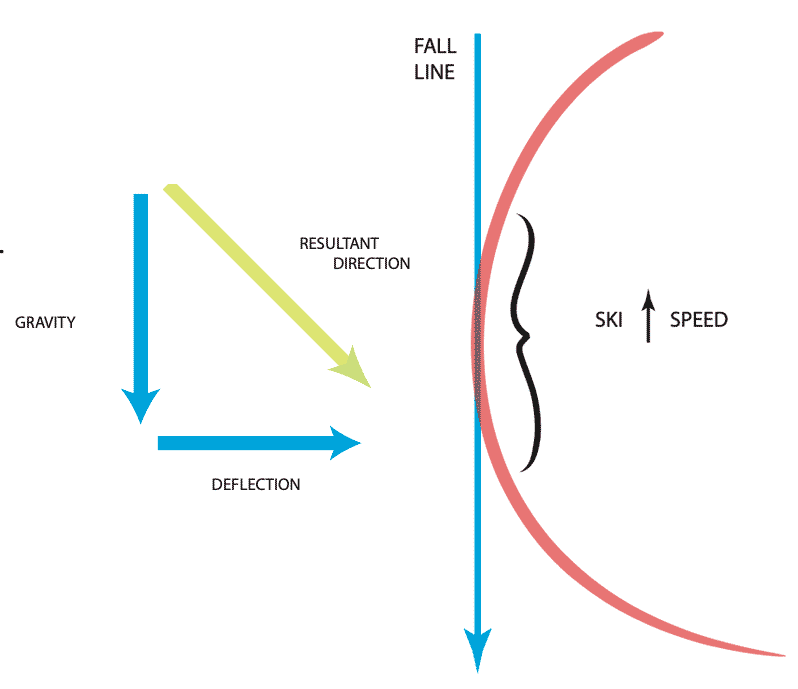
The big picture
Biomechanics
Turning on skis is a result of the equipment deflecting the skier. Every turn is a combination of gravity and deflection induced by pivoting or placing the ski on edge. The result is the net change in direction.
Carving is the most efficient form of turning:
1. Edge (tip the ski over)
2. Pressure (de-camber the ski)
3. Steer (guide the ski through
the foot and lower leg)
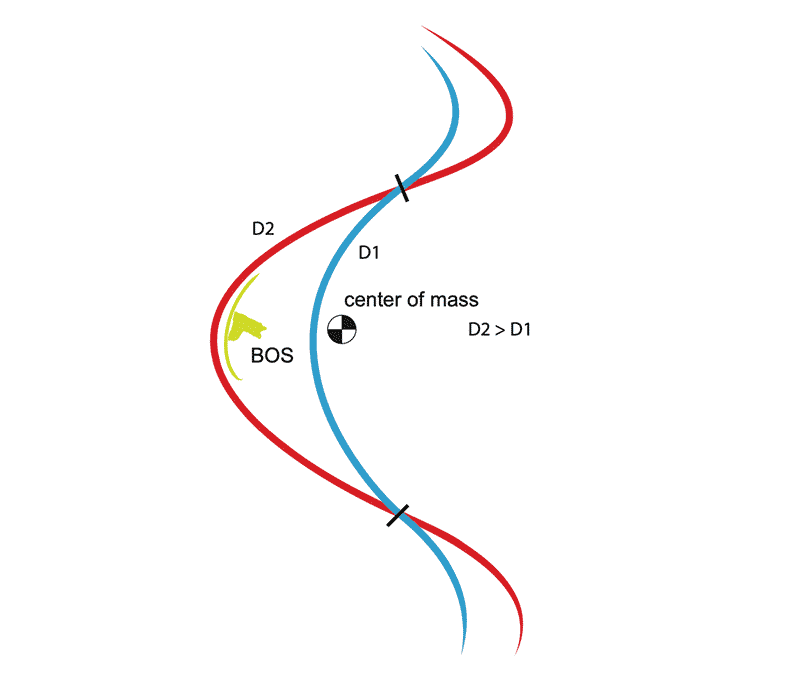
An outcome, and required part, of carving is that the Center of Mass (COM) is inside the arc, as created by the feet (Base of Support - BOS). All body segments are used as levers to create an edge angle, effectively placing the body inside the line. This technique is present in any sport that involves balancing through lateral movement on
equipment that is turning.
In downhill skiing there is an added component moving and balancing relative to the angle of the slope. Skiing requires lateral movements to carve and fore/aft movements to stay in balance with the equipment relative to both speed and pitch.
One key result of the body moving inside the arc is that the COM takes a more direct line through the turn than the feet.
Since both the body and feet are [hopefully!] connected at the start and finish of the turn, by definition the feet must travel faster than the body. On a carving ski, an additional effect on the speed of the feet is gravity in the fall line.
FAQs
What is the Optimal Alignment for Skiing?
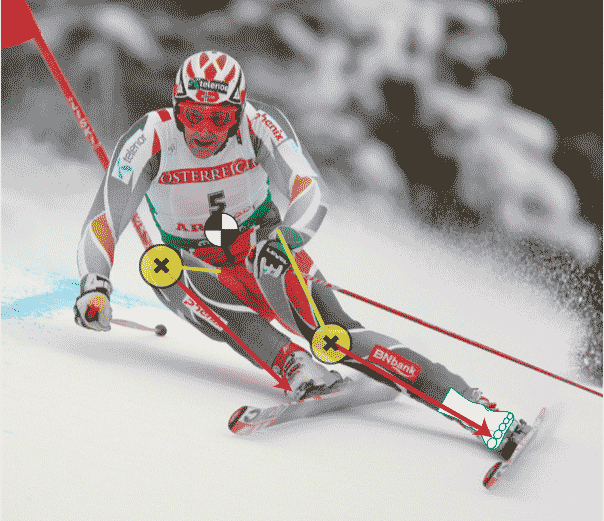
FAQs
What is the Optimal Alignment for Skiing?
Optimal alignment for skiing is more than just a position, it is also a reflection of dynamic movement. There must be enough range of motion and flexibility available in the joints to increase the rates of movement (pronation, flexion, rotation, medial knee drive) to create the extreme angles necessary for high performance skiing.
In terms of static alignment, the optimal position is to be slightly ‘knock-kneed’ with the rearfoot unlocked in mild pronation. This creates a ready position where the
skier can easily and rapidly move inside the arc without having to unlock and move joints from neutral posture.
This ‘knock-kneed’ position also places the centre of knee mass over the working edge of the ski allowing the skier to balance and move easily in relation to the contact point with the hill.
In summary, optimizing alignment:
- Enhances balance and relaxation by reducing compensatory and unnecessary movements.
- Improves mechanics (more efficiency) by placing the knees in line with the inside edge.
- Promotes carving by allowing the joints to move inside the arc.
Carving = Technique + Equipment + Alignment
